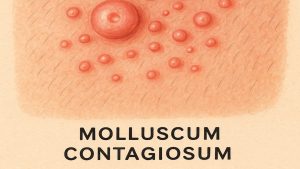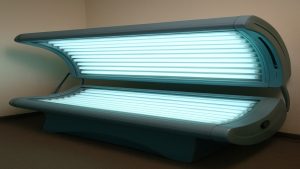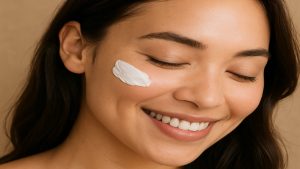- Improves acne, wrinkles, pigmentation, skin texture
- Visible changes often appear after consistent months
- Start with low strength to reduce irritation
- Daily SPF and moisturiser help prevent dryness
- Initial purging may occur before skin clears
Tretinoin, a prescription-only vitamin A derivative, is widely used to improve the appearance of acne-prone and photoaged skin [1]. It supports cell renewal and collagen stimulation, making it a key ingredient in dermatologist-directed routines.
This article explores its science, effects, usage, and what to expect from consistent application.

Understanding Tretinoin
Tretinoin is a topical retinoid prescribed for acne and photoaged skin. It is available in various strengths (typically 0.01% to 0.1%) and formulations, such as creams or gels [2]. Tretinoin should only be used under healthcare supervision to ensure suitability for individual skin types.
The Science Behind Tretinoin
Tretinoin interacts with retinoic acid receptors in skin cells, supporting normal cell turnover and collagen production. These actions can help improve the texture and appearance of the skin over time [1].
Developed in the 1960s by Dr. Albert Kligman and Dr. James Fulton, it remains a well-studied topical treatment in dermatology.
Tretinoin Vs Retinol
Retinol is an over-the-counter cosmetic ingredient that must convert into retinoic acid before becoming active. Tretinoin, by contrast, is already in its active form, meaning it works more directly within the skin [1]. Because of its potency, tretinoin is only available on prescription.
Tretinoin & Skin Cell Turnover
By supporting cell renewal, tretinoin helps prevent pore blockage and surface buildup that may contribute to acne formation. Regular use can enhance smoothness and clarity of the complexion [2].
Tretinoin’s Benefits
Wrinkle Reduction & Fine Line Improvement
Tretinoin has been studied for its role in improving the appearance of fine lines and wrinkles. In clinical research, 0.05% formulations used over several months demonstrated measurable changes in photoaged skin [3,4].
Youthful-Looking Skin & Elasticity
Through long-term use, tretinoin supports improved firmness and tone. These effects develop gradually as collagen synthesis and cell renewal continue [1].
Hyperpigmentation & Uneven Tone
Tretinoin may help reduce the visibility of dark spots and uneven tone over time by encouraging cell turnover [1]. It is sometimes prescribed for pigmentation disorders such as melasma under clinical guidance.
Texture & Smoothness
Users often report a smoother feel as rough or uneven areas improve with ongoing treatment [3].
Pore Appearance
By keeping pores clear, tretinoin can help reduce the visible prominence of pores, promoting a more refined appearance [2].
Before & After: What To Expect
Wrinkles & Fine Lines
In studies, regular tretinoin application improved the appearance of photoaged skin over 6 to 12 months [3]. The skin may appear smoother and more even in tone.
Hyperpigmentation & Dark Spots
Gradual fading of sun-induced pigmentation or post-acne marks can occur with consistent use, though results vary by individual [1].
Pores & Texture
Many users notice refinement of texture and pore visibility after months of continuous use [2].
Consistency & Patience
Visible improvements take time. In the first 2–6 weeks, temporary purging or dryness may occur [2]. Regular, correct use over several months typically provides the most noticeable outcomes.
How To Use Tretinoin For Best Results
Start Slow
Introduce tretinoin gradually (once or twice a week), especially for new users. Starting at a lower concentration such as 0.025% helps minimise dryness and irritation [2].
Apply To Clean & Dry Skin
Apply a pea-sized amount to clean, fully dry skin, avoiding sensitive areas like eyes and lips. Allow skin to dry for at least 20 minutes after cleansing [2].
Use A Pea-Size Amount
A small amount (roughly 0.25 g) is sufficient for the face. Applying more will not increase results and may increase irritation [2].
Moisturise & Protect
Always follow tretinoin with a gentle moisturiser. Daily sunscreen (SPF 30 or higher) is essential to prevent sun sensitivity and maintain skin health [2].
Potential Side Effects
Temporary redness, peeling, and dryness are common early reactions. These effects typically settle within several weeks [2]. Persistent discomfort should be reviewed by a prescribing clinician.
Managing Initial Irritation
Hydrating cleansers and moisturisers can help relieve dryness. Avoid combining tretinoin with other potentially irritating actives such as benzoyl peroxide or strong exfoliants unless directed by a clinician [2].
Long-Term Use & Tolerance
With continued use, most users find that their skin adjusts to tretinoin, allowing smoother and more even texture to emerge [3]. Maintaining consistency supports sustained benefits.
When To Seek Professional Advice
If irritation, dryness, or breakouts persist, consult a healthcare professional. They may recommend adjusting application frequency or strength. Clinical guidance ensures tretinoin is used safely and effectively.
Transformational Journeys
Long-term users often describe noticeable improvements in texture, clarity, and tone, contributing to overall skin confidence. Tretinoin has also shown promise in the management of early stretch marks under medical supervision [3].
Conclusion
Tretinoin can improve multiple visible signs of ageing and acne-related concerns when used consistently under professional direction. Results develop gradually, requiring patience, sun protection, and supportive skincare.
Those considering tretinoin should consult a healthcare professional for tailored advice. You can receive personalised guidance through a free online consultation reviewed by a GPhC-registered prescriber.
Content is for informational purposes only. Monderma treatments are prescribed following consultation. Results and timeframes can vary. Use as directed by your prescriber.
Bibliography
- Kang, S., et al. (1996). Topical tretinoin (retinoic acid) improves early stretch marks. Archives of Dermatology, 132(5), 519–526.
- Noble, S., & Wagstaff, A. J. (1995). Tretinoin: A review of its pharmacological properties and clinical efficacy in the topical treatment of photodamaged skin. Drugs & Aging, 6(6), 479–496.
- Schmidt, N., & Gans, E. H. (2011). Tretinoin: A review of its anti-inflammatory properties in the treatment of acne. Journal of Clinical and Aesthetic Dermatology, 4(11), 22–29.
- Weinstein, G. D., et al. (1991). Topical tretinoin for treatment of photodamaged skin: A multicenter study. Archives of Dermatology, 127(5), 659–665.
Find your perfect skincare formula
Takes less than 2 minutes – see what your skin needs
Get Custom Formula













